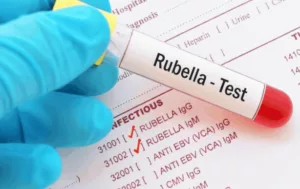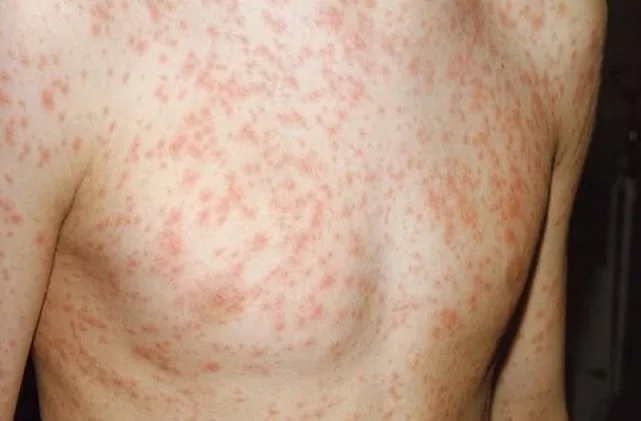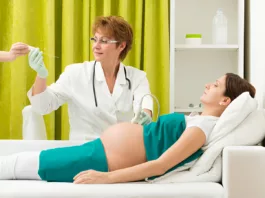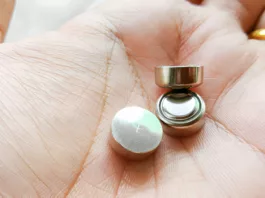What is Congenital Rubella Syndrome?
Congenital Rubella Syndrome (CRS) is a viral disease resulting from primary maternal infection in newborns. It occurs when a pregnant woman contracts the rubella virus (also known as German measles) and passes it on to her unborn baby. Rubella is a contagious viral infection that primarily affects the respiratory system and is typically characterized by a rash.1Paller, A. S., & Mancini, A. J. (2016, January 1). 2 – Cutaneous Disorders of the Newborn (A. S. Paller & A. J. Mancini, Eds.). ScienceDirect; Elsevier. Retrieved April 24, 2023, from: https://www.sciencedirect.com/science/article/abs/pii/B9780323244756000029. The virus invades the upper respiratory tract and spreads to different sites, including the placenta.
The risk of infecting the fetus becomes significant if the mother gets an infection in early pregnancy, usually in the first trimester. The only way to prevent this serious health problem is through vaccination.
Causes
CRS is caused by a highly contagious enveloped RNA virus, the Rubella virus. It spreads through tiny droplets in the air from the nose and throat or via close contact. Also, you may catch the virus by inhaling the droplets of an infected person or touching a contaminated object. Rubella also transmits through the bloodstream from a pregnant woman to her developing baby via the placenta or umbilical cord.
It occurs when the developing baby gets infected in the first 12 weeks of pregnancy. If the mother gets an infection late in the second trimester, it is less likely to harm the baby. Pregnant women and their developing babies are vulnerable to CRS if they are not vaccinated for rubella or have not had Rubella before.
Rubella and Pregnancy
Rubella virus can cross the Blood Placenta Barrier, which is a barrier composed of maternal and fetal tissue. The purpose of this barrier is to help prevent the crossing of most of the toxic materials and pathogens from mother to fetus2Yong HEJ, Chan SY, Chakraborty A, Rajaraman G, Ricardo S, Benharouga M, Alfaidy N, Staud F, Murthi P. Significance of the placental barrier in antenatal viral infections. Biochim Biophys Acta Mol Basis Dis. 2021 Dec 1;1867(12):166244. doi: 10.1016/j.bbadis.2021.166244. Epub 2021 Aug 16. PMID: 34411716..
Once the rubella virus crosses this barrier, it results in causing Congenital Rubella Syndrome. CRS can significantly increase the risk of stillbirths, miscarriages, and birth defects in the newborns. Common defects include:
- Intellectual disabilities and retarded mental growth
- Imparied hearing
- Defected vision
- Congenital heart defects,
- Liver and spleen abnormalities,
- General growth restrictions
Signs & Symptoms
In a pregnant woman, it may exist without any symptoms. However, a patient may experience various symptoms such as
- Upper respiratory tract symptoms
- Conjunctivitis
- Low-grade fever
- Swollen lymph nodes
- Maculopapular rash.
Joint problems may follow this illness.
Infants born with this disease may commonly present with some or all of these signs and symptoms3 L.Tesini, B. (2022, September). Congenital Rubella – Pediatrics. MSD Manual Professional Edition. Retrieved April 23, 2023, from: https://www.msdmanuals.com/professional/pediatrics/infections-in-neonates/congenital-rubella:
- Heart problems
- Vision defects, including cataracts and glaucoma
- Growth retardation
- Low birth weight
- Delayed development
- Learning and intellectual disabilities
- Impaired hearing
- Diabetes mellitus
- Enlarged liver and spleen
- Skin lesions and rashes
- Immune deficiencies
- Bleeding
How to Diagnose Congenital Rubella?
Diagnosis and evaluation usually involve laboratory testing. Following are the common ways to diagnose congenital rubella at different stages4Shukla, S., & Maraqa, N. F. (2020). Congenital Rubella. PubMed; StatPearls Publishing. Retrieved April 23, 2023, from: https://www.ncbi.nlm.nih.gov/books/NBK507879/:
Maternal screening
Confirm the diagnosis if rubella-like sickness occurs in the early stages of pregnancy. Screening expectant mothers for rubella early in pregnancy can help confirm the infection. RV-IgG (Rubella Virus Immunoglobulin G) and IgM (Immunoglobulin M) titers can monitor seroconversion in the laboratory.

Various other antibodies and infection markers can also be checked with blood testing. The test results will indicate either current or past infection to which antibodies have been developed.
Prenatal Diagnosis in Fetus
Prenatal diagnosis usually detects the viral genome in fetal fluids. It might involve the examination of fetal blood, amniotic fluid, or chorionic villus biopsies.
Postnatal Diagnosis
It uses an ELISA test to find RV-IgG antibodies in newborn serum. The strategy is almost entirely appropriate for newborns under three months old. Using the reverse transcriptase polymerase chain reaction (RT-PCR), the virus can be found in nasopharyngeal swabs, urine, and oral fluid to confirm an infection.
Steady or increasing serum levels of rubella-specific IgG throughout the first year of life can also indicate congenital infection. Diagnosing it in children older than a year can be challenging.
Other Tests
Other tests may include CSF analysis or an X-ray of the bones to detect characteristic radiolucencies. Thorough cardiac and ophthalmologic evaluations are also helpful in detecting CRS.
Precautions
Following are a few precautions you should consider regarding Rubella:
- After getting it, you’ll be infectious to other people from one week before symptoms develop to four days after the rash first appears. Isolate yourself for seven days after developing a rash.
- Take bed rest and paracetamol to relieve discomfort from fever and aches.
- After the rash appears, avoid going to work or school for four days to prevent the virus from spreading.
- Strictly avoid contact with pregnant women during this period.
- Hand hygiene is vital for reducing viral transmission from the urine of children suffering from it.
Rubella Vaccine
An effective immunization program can help prevent it5Control and Prevention of Rubella: Evaluation and Management of Suspected Outbreaks, Rubella in Pregnant Women, and Surveillance for Congenital Rubella Syndrome. (2018). Centers for Disease Control and Prevention. Retrieved April 24, 2023, from: https://www.cdc.gov/mmwr/preview/mmwrhtml/rr5012a1.htm. Infants must receive a combined measles, mumps, and rubella (MMR) vaccine. The first vaccination is given at 12 to 15 months, and the second at 4 to 6 years of age6 J. Smith, M. (2021, November). Childhood Vaccination Schedule – Pediatrics. MSD Manual Professional Edition. Retrieved April 24, 2023, from: https://www.msdmanuals.com/professional/pediatrics/childhood-vaccination/childhood-vaccination-schedule.
Adolescent females who are not immune to rubella should be vaccinated. After vaccination, women should not become pregnant for at least 28 days. MMR before pregnancy minimizes the chance of congenital rubella. However, It’s vaccination is usually not advised for immunocompromised or pregnant women.
Rubella Treatments
Most cases of it do not require hospitalization, and you can manage them at home. There is no specific treatment for it. However, the following measures can help reduce symptoms and prevent viral spread.
Antibodies
Physicians may treat pregnant women with intramuscular Immune Globulin (IG) antibodies. These antibodies can fight the virus and help reduce symptoms. However, they only offer a limited benefit. However, there’s still a risk that the baby will develop CRS.
Supportive Care
Beyond these measures, doctors can also recommend supportive care to manage symptoms. This can include:
- Adequate rest
- Ibuprofen or Paracetamol to treat fever
- Drinking plenty of fluids
- A humidifier
Rubeola vs. Rubella
Rubella and Rubeola are both highly contagious airborne viral infections, presenting with fever and a rash. Rubeola, known as measles, is caused by a paramyxovirus, whereas the Rubella virus causes Rubella. Symptoms are almost similar, with slightly different timing and appearance of the rash and fever. A combined MMR vaccine can prevent both.
The Bottomline
It is a viral illness characterized by maculopapular rash, lymphadenopathy, and fever. It is a highly contagious but generally mild disease. However, maternal infection during early pregnancy can cause severe fetal malformation syndrome. Prevention must be the goal, as there is no known cure for it.
Refrences
- 1Paller, A. S., & Mancini, A. J. (2016, January 1). 2 – Cutaneous Disorders of the Newborn (A. S. Paller & A. J. Mancini, Eds.). ScienceDirect; Elsevier. Retrieved April 24, 2023, from: https://www.sciencedirect.com/science/article/abs/pii/B9780323244756000029
- 2Yong HEJ, Chan SY, Chakraborty A, Rajaraman G, Ricardo S, Benharouga M, Alfaidy N, Staud F, Murthi P. Significance of the placental barrier in antenatal viral infections. Biochim Biophys Acta Mol Basis Dis. 2021 Dec 1;1867(12):166244. doi: 10.1016/j.bbadis.2021.166244. Epub 2021 Aug 16. PMID: 34411716.
- 3L.Tesini, B. (2022, September). Congenital Rubella – Pediatrics. MSD Manual Professional Edition. Retrieved April 23, 2023, from: https://www.msdmanuals.com/professional/pediatrics/infections-in-neonates/congenital-rubella
- 4Shukla, S., & Maraqa, N. F. (2020). Congenital Rubella. PubMed; StatPearls Publishing. Retrieved April 23, 2023, from: https://www.ncbi.nlm.nih.gov/books/NBK507879/
- 5Control and Prevention of Rubella: Evaluation and Management of Suspected Outbreaks, Rubella in Pregnant Women, and Surveillance for Congenital Rubella Syndrome. (2018). Centers for Disease Control and Prevention. Retrieved April 24, 2023, from: https://www.cdc.gov/mmwr/preview/mmwrhtml/rr5012a1.htm
- 6J. Smith, M. (2021, November). Childhood Vaccination Schedule – Pediatrics. MSD Manual Professional Edition. Retrieved April 24, 2023, from: https://www.msdmanuals.com/professional/pediatrics/childhood-vaccination/childhood-vaccination-schedule





